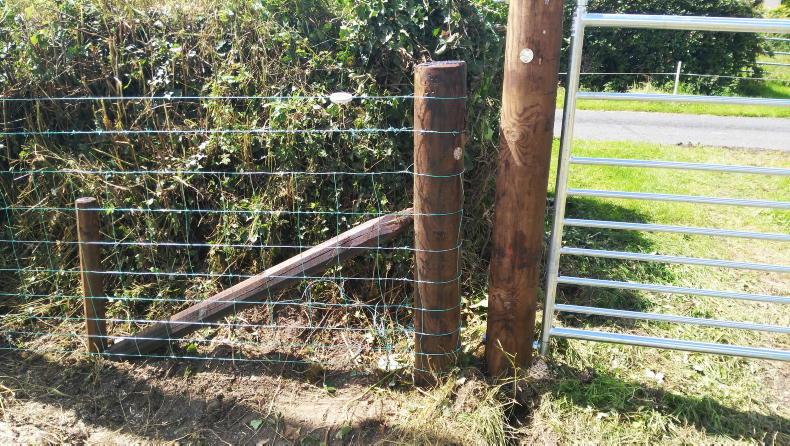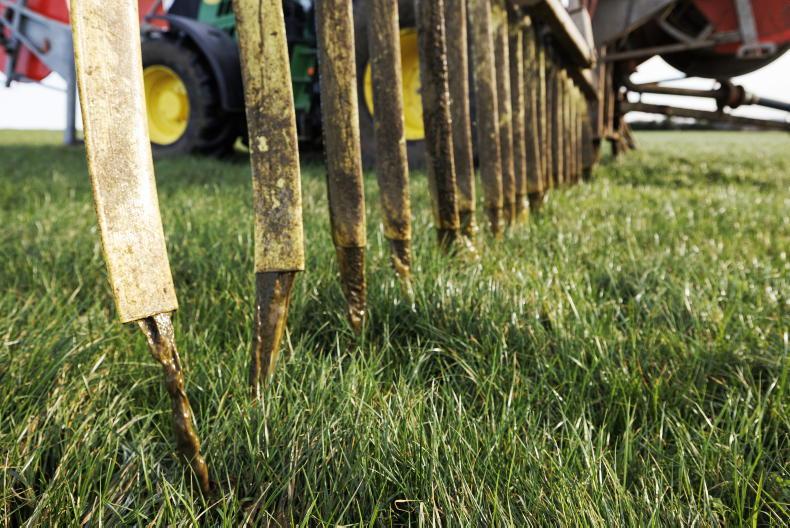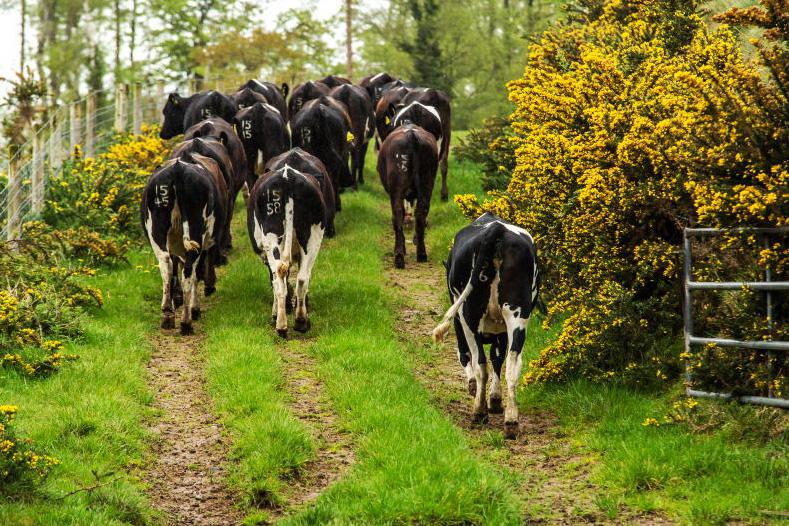While fertiliser and feed costs have reduced from the peak levels witnessed in 2022, they are still trending well above the long term average, while energy costs also remain stubbornly high.
With farmers also enduring an expensive spring due to adverse weather, the aim for the remainder of the season must be to try and get the grazing season back on track as soon as possible and drive performance from grass.

Once animals become accustomed to temporary fencing there is massive potential to manage grass better. This is shown here where the field has been divided to save high-quality silage.
Optimising grazing infrastructure is key in this regard. The ideal scenario is a rotational grazing system where animals have access to fresh grass on a regular basis and grassland can be easier managed during the peak growing season.
This includes availing of opportunities to cut surplus grass, thereby boosting supplies of high-quality winter forage while also providing a source of top-quality grass for grazing.
Grazing infrastructure
If we use an example of a 100 ewe flock on high-performing swards, Teagasc advice is for at least five grazing divisions of approximately 2ha (five acres) in size, which can be temporarily divided to give scope for 10 grazing divisions.
This equates to a stocking rate of approximately 10 ewes/ha. Research by Teagasc shows that a ewe and her two lambs will require 1kg grass dry matter, meaning at a stocking rate of 10 ewes/ha an average of 10t grass dry matter will need to be produced across the year to sustain production.
The size of grazing divisions should also take account of the farm’s growth potential. Increasing grazing divisions will provide an opportunity to increase herbage production over the season.

Systems such as this seen on John Bell's farm in Co Westmeath at an IGA event a few years ago allow temporary divisions to be erected with ease.
Such a scenario of optimally aligning the size of paddocks to suit grazing groups offers the potential for a shorter residency period of two-to-three days.
The aim during the main grazing season is for sheep to enter paddocks at pre-grazing sward heights of 7cm to 9cm or covers of about 1,200kg to 1,500kg DM/ha and removed once swards are grazed to 4cm to 4.5cm or higher as the season progresses.
A similar rotational grazing system will not suit everyone, but there are still improvements that can be made to a set-stocking type system by increasing the number of grazing divisions and being able to better manage grass during peak growth.
Low-cost options
Permanent posts and sheep wire are generally the best option when dividing large areas with the intention of making these permanent divisions.
But given the fact that fencing materials and particularly timber posts have increased in cost lower-cost options may be more palatable where cashflow is tight.
A combination of permanent and lower-cost temporary divisions is another option.

Here temporary grazing divisions are joined to a permanent division with insulated handles. This allows voltage to be confined to a smaller area.
Permanent fencing will cost upwards of €6/m to €9/m where completed by a contractor. While on the subject, reference costs under the Targeted Agricultural Modernisation Scheme (TAMS) need to be reviewed and revised to take account of the higher cost of materials.
In contrast a combination of timber/pvc or pigtail posts and polywire/mild steel wire can be erected at a fraction of a cost ranging anywhere from €1.30/m to upwards of €2/m.
An added benefit of this system is that it gives an opportunity to test if fencing is erected in the best site.
Utilising temporary fencing can also allow mixed grazing systems to be implemented to good effect. This can have an equally positive influence on animal performance.
Useful tips
One of the most important aspects of successfully implementing grazing infrastructure with temporary electric fencing is to train the animals to the system at the outset.
This includes erecting a robust fence at the outset that will better stand up to being challenged.
It is advised to start with four strands of wire at a height of 20cm, 30cm, 50cm and 80cm above ground level, and with additional posts.

Here temporary grazing divisions are joined to a permanent division with insulated handles. This allows voltage to be confined to a smaller area.
Once sheep get accustomed to the fence, then one of the bottom strands of wire can be removed – most commonly it is the 20cm wire that is removed.
The benefit of setting up a smaller area is that it maximises the voltage running through the wire.
It is important to consider the capacity of the fencer, and to take account of each strand of wire, i.e. 200m of a three strand fence is 600m length of fencing.
A mains system works best, but mobile fencers can also work well where there are cut-out switches or breaks in the circuit to allow the voltage to be concentrated on the area being grazed.
Where joining wire onto polywire, then it is advisable to do so at the start of the reel, as wire can become damaged over time and it will be much easier to snip damaged ends rather than trying to reconnect wire in the middle of a section.
There is a growing range of equipment on the market for maximising the benefits of such systems including wire reels, insulating handles, insulators for PVC posts etc.
Where temporary fencing is being erected and taken down frequently, then geared reels costing on average from €40 to €80 are a really useful addition.
Water supply
Having a sufficient water supply is often identified as a big barrier to splitting up paddocks. There are options however to overcome these challenges.
Where a piped water connection exists, the most straightforward of these is to run a length of piping over the ground joined to a moveable water trough.
Other systems developed to good effect in recent years include IBC tanks and troughs set up on trailers which can be easily moved.

Permanent field divisions do not have to include sheep wire with permanent electric wire an option. A good mains fencer is required in such a scenario.
Key points
Increasing the number of grazing divisions offers the potential to better manage grass during the peak grass-growing system. Taking small steps and starting with one to two grazing divisions or splitting large areas will provide a platform to build from. The secret to temporary electrified fencing divisions is to set up a robust fence at the outset to get animals accustomed to it. Unlocking the potential for mixed grazing will also deliver big gains in animal performance and herbage utilisation.
While fertiliser and feed costs have reduced from the peak levels witnessed in 2022, they are still trending well above the long term average, while energy costs also remain stubbornly high.
With farmers also enduring an expensive spring due to adverse weather, the aim for the remainder of the season must be to try and get the grazing season back on track as soon as possible and drive performance from grass.

Once animals become accustomed to temporary fencing there is massive potential to manage grass better. This is shown here where the field has been divided to save high-quality silage.
Optimising grazing infrastructure is key in this regard. The ideal scenario is a rotational grazing system where animals have access to fresh grass on a regular basis and grassland can be easier managed during the peak growing season.
This includes availing of opportunities to cut surplus grass, thereby boosting supplies of high-quality winter forage while also providing a source of top-quality grass for grazing.
Grazing infrastructure
If we use an example of a 100 ewe flock on high-performing swards, Teagasc advice is for at least five grazing divisions of approximately 2ha (five acres) in size, which can be temporarily divided to give scope for 10 grazing divisions.
This equates to a stocking rate of approximately 10 ewes/ha. Research by Teagasc shows that a ewe and her two lambs will require 1kg grass dry matter, meaning at a stocking rate of 10 ewes/ha an average of 10t grass dry matter will need to be produced across the year to sustain production.
The size of grazing divisions should also take account of the farm’s growth potential. Increasing grazing divisions will provide an opportunity to increase herbage production over the season.

Systems such as this seen on John Bell's farm in Co Westmeath at an IGA event a few years ago allow temporary divisions to be erected with ease.
Such a scenario of optimally aligning the size of paddocks to suit grazing groups offers the potential for a shorter residency period of two-to-three days.
The aim during the main grazing season is for sheep to enter paddocks at pre-grazing sward heights of 7cm to 9cm or covers of about 1,200kg to 1,500kg DM/ha and removed once swards are grazed to 4cm to 4.5cm or higher as the season progresses.
A similar rotational grazing system will not suit everyone, but there are still improvements that can be made to a set-stocking type system by increasing the number of grazing divisions and being able to better manage grass during peak growth.
Low-cost options
Permanent posts and sheep wire are generally the best option when dividing large areas with the intention of making these permanent divisions.
But given the fact that fencing materials and particularly timber posts have increased in cost lower-cost options may be more palatable where cashflow is tight.
A combination of permanent and lower-cost temporary divisions is another option.

Here temporary grazing divisions are joined to a permanent division with insulated handles. This allows voltage to be confined to a smaller area.
Permanent fencing will cost upwards of €6/m to €9/m where completed by a contractor. While on the subject, reference costs under the Targeted Agricultural Modernisation Scheme (TAMS) need to be reviewed and revised to take account of the higher cost of materials.
In contrast a combination of timber/pvc or pigtail posts and polywire/mild steel wire can be erected at a fraction of a cost ranging anywhere from €1.30/m to upwards of €2/m.
An added benefit of this system is that it gives an opportunity to test if fencing is erected in the best site.
Utilising temporary fencing can also allow mixed grazing systems to be implemented to good effect. This can have an equally positive influence on animal performance.
Useful tips
One of the most important aspects of successfully implementing grazing infrastructure with temporary electric fencing is to train the animals to the system at the outset.
This includes erecting a robust fence at the outset that will better stand up to being challenged.
It is advised to start with four strands of wire at a height of 20cm, 30cm, 50cm and 80cm above ground level, and with additional posts.

Here temporary grazing divisions are joined to a permanent division with insulated handles. This allows voltage to be confined to a smaller area.
Once sheep get accustomed to the fence, then one of the bottom strands of wire can be removed – most commonly it is the 20cm wire that is removed.
The benefit of setting up a smaller area is that it maximises the voltage running through the wire.
It is important to consider the capacity of the fencer, and to take account of each strand of wire, i.e. 200m of a three strand fence is 600m length of fencing.
A mains system works best, but mobile fencers can also work well where there are cut-out switches or breaks in the circuit to allow the voltage to be concentrated on the area being grazed.
Where joining wire onto polywire, then it is advisable to do so at the start of the reel, as wire can become damaged over time and it will be much easier to snip damaged ends rather than trying to reconnect wire in the middle of a section.
There is a growing range of equipment on the market for maximising the benefits of such systems including wire reels, insulating handles, insulators for PVC posts etc.
Where temporary fencing is being erected and taken down frequently, then geared reels costing on average from €40 to €80 are a really useful addition.
Water supply
Having a sufficient water supply is often identified as a big barrier to splitting up paddocks. There are options however to overcome these challenges.
Where a piped water connection exists, the most straightforward of these is to run a length of piping over the ground joined to a moveable water trough.
Other systems developed to good effect in recent years include IBC tanks and troughs set up on trailers which can be easily moved.

Permanent field divisions do not have to include sheep wire with permanent electric wire an option. A good mains fencer is required in such a scenario.
Key points
Increasing the number of grazing divisions offers the potential to better manage grass during the peak grass-growing system. Taking small steps and starting with one to two grazing divisions or splitting large areas will provide a platform to build from. The secret to temporary electrified fencing divisions is to set up a robust fence at the outset to get animals accustomed to it. Unlocking the potential for mixed grazing will also deliver big gains in animal performance and herbage utilisation. 













SHARING OPTIONS